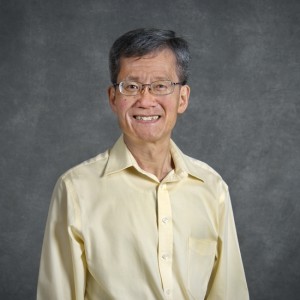
Kam-Biu Luk holds joint appointments with Berkeley Lab’s Physics Division, and the University of California Berkeley Physics Department. He is the co-spokesperson for the Daya Bay Experiment.
For the second year in a row, a faculty scientist with the Lawrence Berkeley National Laboratory (Berkeley Lab) has been named a recipient of the prestigious W.K.H. Panofsky Prize, awarded annually by the American Physical Society (APS) to recognize outstanding achievements in experimental particle physics.
Kam-Biu Luk, who holds joint appointments with Berkeley Lab’s Physics Division, and the University of California Berkeley Physics Department, will share the 2014 Panofsky Prize with Yifang Wang of China’s Institute of High Energy Physics for their work on the Daya Bay Reactor Neutrino Experiment.
The citation reads, “For their leadership of the Daya Bay experiment, which produced the first definitive measurement of θ13 angle of the neutrino mixing matrix.”
The on-going Daya Bay Experiment in the south of China is a multinational collaboration for the study of neutrinos, the ghostlike particles produced by our sun and other stars, and in nuclear reactors. Luk and Wang are the co-spokespersons for the experiment. Luk was also the scientist who identified the powerful nuclear reactors of the China Guangdong Nuclear Power Group as the ideal site for the experiment. Berkeley Lab is the lead U.S. Department of Energy (DOE) national laboratory for the Daya Bay Experiment, which receives support from DOE’s Office of Science High Energy Physics program.
“It is a great honor to share this prize with Yifang,” Luk said. “The Panofsky prize holds a special meaning to the Daya Bay Experiment. Professor Pief Panofsky offered valuable advice, support, and assistance in cementing this major U.S.-China collaboration. I am sure he would have been very pleased to witness the truly remarkable discoveries being made at Daya Bay.”
The Panofsky Prize, which was established in 1985 to honor the late Stanford physicist Wolfgang “Pief” Panofsky, consists of $10,000, an allowance for travel to the APS meeting at which the prize is to be awarded, and a certificate citing the contributions made by the recipient. The 2013 Panofsky prize was shared by Bernard Sadoulet, who also holds joint appointments with Berkeley Lab Physics Division and UC Berkeley’s Physics Department.
“This is a timely and well-deserved recognition for both Kam-Biu and Yifang, whose scientific vision and perseverance have led to the remarkable success of the Daya Bay experiment,” said Natalie Roe, director of Berkeley Lab’s Physics Division. “I expect we will see ever greater precision on neutrino properties from Daya Bay in the coming years.”

The Daya Bay Experiment in the south of China is a multinational collaboration for the study of neutrinos that could help answer some of the most vexing mysteries of our universe
There are a great many unanswered questions about our universe, none more basic than why it even exists as it does. In the aftermath of the big bang, particles of matter and antimatter should have annihilated one another, resulting in a universe of pure energy. Something happened to favor matter over antimatter, resulting in the universe we observe today. Neutrinos are nearly massless and electrically neutral particles that travel pretty much untouched through space and time. Because of this phantomlike nature, neutrinos are believed to hold invaluable clues about the history of our early universe.
The Daya Bay experiment, for which Luk and Wang are being recognized, is designed to reveal details of how the three types or “flavors” of neutrinos – electron, muon and tau – mix together and exchange identities as they travel, a phenomenon called “neutrino oscillation.” The experiment also measures key difference in neutrino masses, a property known as “mass splitting.” This information could help answer many of the questions we have about the universe.
“The Daya Bay collaboration has had to overcome numerous obstacles but in the end, the accomplishments of the Daya Bay Experiment have exceeded our expectations,” Luk said. “We are grateful that the Daya Bay experiment has been recognized by the particle-physics community.”
Luk, who was born in Hong Kong, attended the University of Hong Kong from 1973 to 1976 and received his B.Sc. in Physics. He was awarded his Ph.D. from Rutgers University in 1983 and did postdoctoral research at the University of Washington in Seattle. In 1986 when he went to Fermilab where he received the R.R. Wilson Fellow of Fermilab during his three years there. He has been a faculty scientist at Berkeley Lab and UC Berkeley since 1989.
Additional Information
For more about the international Daya Bay Collaboration go here